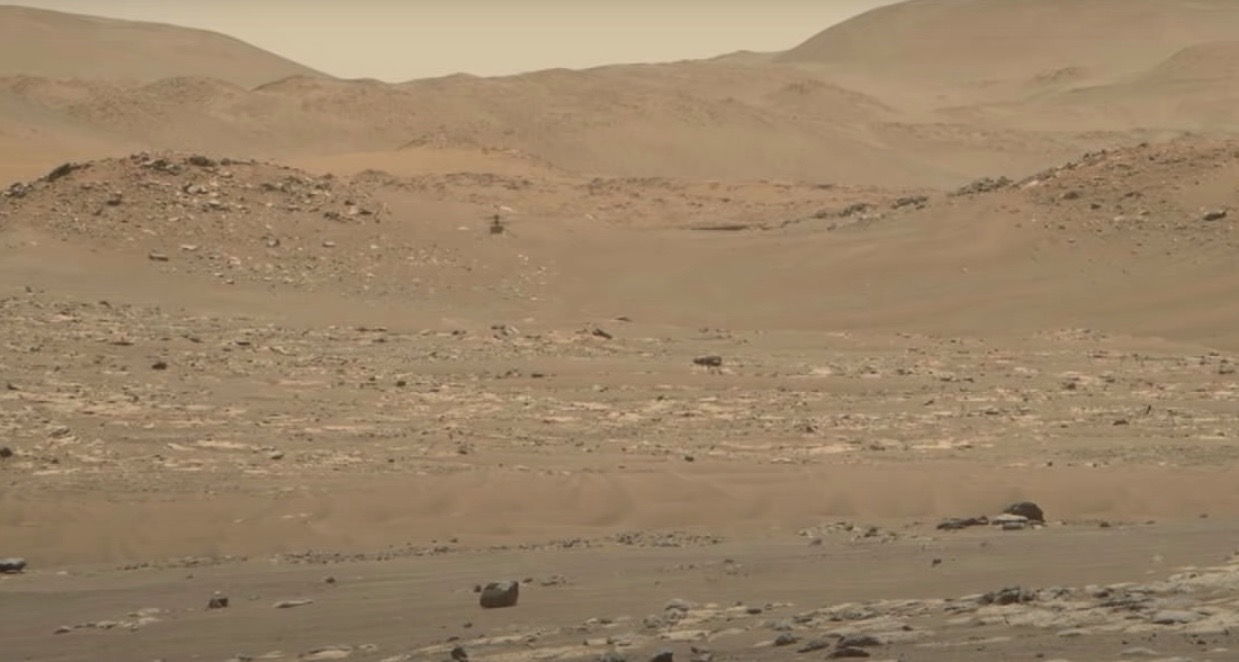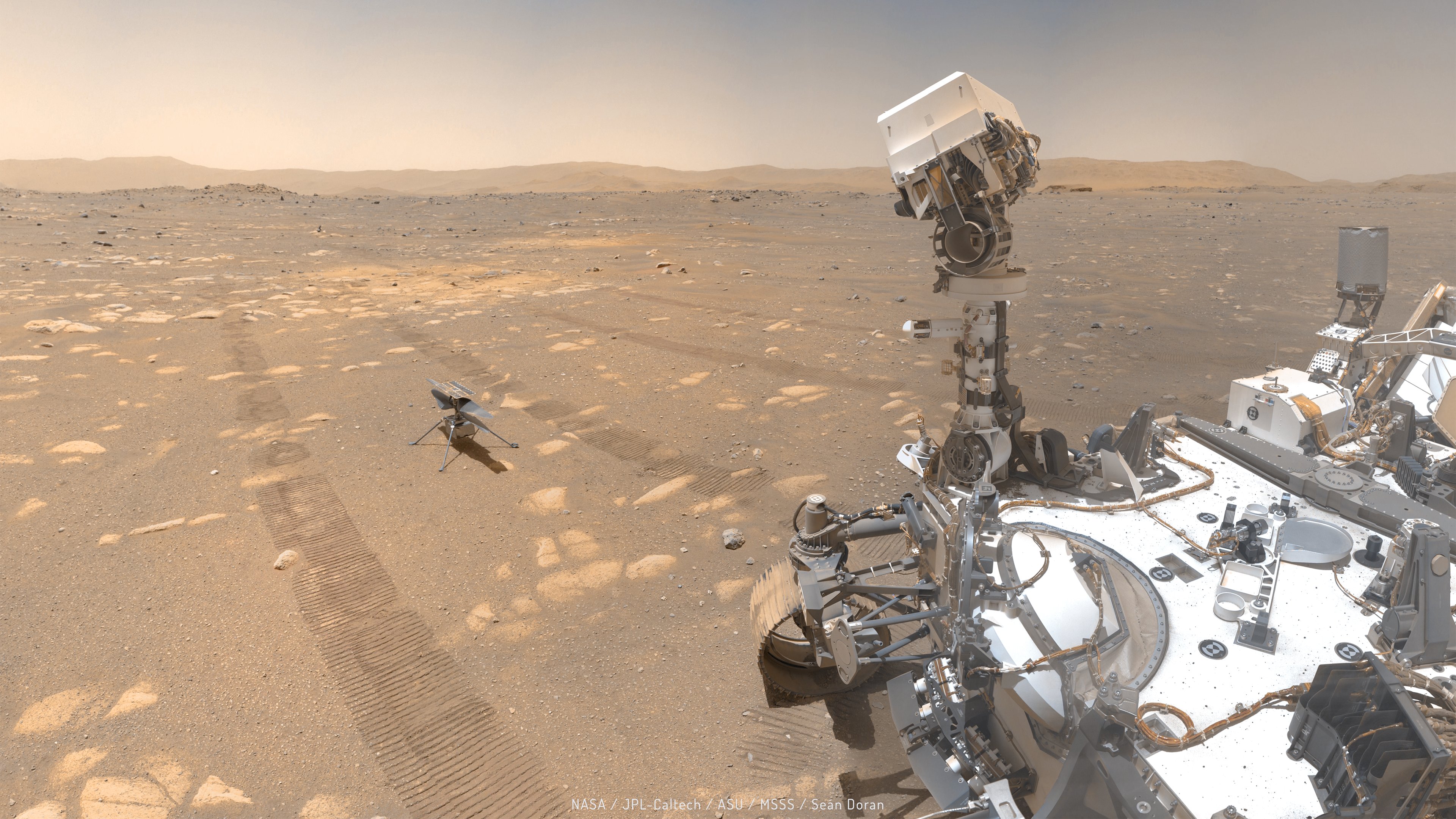
One year ago today (April 19), an aircraft flew on a world beyond Earth for the first time ever.
That history-making vehicle is NASA's Ingenuity Mars helicopter, which landed inside the Red Planet's Jezero Crater with the life-hunting, sample-caching Perseverance rover on Feb. 18, 2021. Just over two months later, the 4-pound (1.8 kilograms) Ingenuity made its first foray into the Martian skies, hovering about 10 feet (3 meters) above the red dirt of a site named, appropriately enough, Wright Brothers Field.
With that 39-second sortie, Ingenuity showed that aerial exploration is possible on Mars, which has an atmosphere just 1% as dense as that of Earth at sea level. That was the main goal of the little helicopter's technology-demonstrating mission, which called for five pioneering flights over the course of 30 Martian days, or sols. (One sol is just slightly longer than an Earth day — about 24 hours and 40 minutes.)
Related: 1 year later, Ingenuity helicopter still going strong on Mars
Ingenuity sailed through that initial campaign and just kept on flying. One year later, the little chopper has 25 flights under its belt and is still going strong.
"It's still sort of a surreal feeling," said Ingenuity chief engineer Jaakko Karras, who's based at NASA's Jet Propulsion Laboratory (JPL) in Southern California, which manages Ingenuity's mission.
"I think we would have all said that we'd consider ourselves lucky if we could get just the one flight and land safely, and extremely lucky if we could get to the end of that initial 30-sol tech-demo window with five flights under our belts," Karras told Space.com. "To be here now, though, a full Earth year later, having flown 25 flights, over 45 minutes spent in the Martian sky over all kinds of different terrain that we never planned for, never designed for — it's pretty incredible."
Get the Space.com Newsletter
Breaking space news, the latest updates on rocket launches, skywatching events and more!
The Ingenuity team has been pushing the helicopter's limits during its extended mission. For example, on its 25th flight, which took place on April 8, Ingenuity covered 2,310 feet (704 m) of ground and reached a top speed of 12.3 mph (19.8 kph) — both personal bests.
Ingenuity has also taken on reconnaissance duties: The rotorcraft's aerial observations are now helping the Perseverance team plan the safest, most efficient routes for the rover and identify potential science targets.
"That's been another wonderful aspect of this extended operations phase for us, is actually getting to serve that scout role, which has always been kind of a guiding vision and aspiration for this technology," Karras said. "We never anticipated being able to actually do it with Ingenuity. We thought that we'd be a demo and that would be it."
Ingenuity's longevity and adaptability are a testament to its solid engineering and the creativity of its handlers, Karras said. For example, the chopper's navigation software was designed to deal only with flat, relatively hazard-free terrain. But it's robust and flexible enough to allow Ingenuity to fly over some seriously rugged landscapes, he added, such as Jezero's dune-studded Séítah region.
The Ingenuity team has uploaded some software updates over the past 12 months, but those have mainly just served to patch minor problems that have cropped up here and there, Karras said.
"The software updates thus far, I'd say, are really only scratching the surface of what we could still do," he said.

Ingenuity remains in good health, so it should keep flying for a while yet, helping Perseverance explore the ancient river delta that once existed within Jezero. And Ingenuity's work is laying the foundation for even greater Martian aerial feats in the future.
For example, engineers at JPL are already drawing up plans for bigger, more capable successors — rotorcraft that could explore Mars on their own. (All communications to and from the solar-powered Ingenuity must go through Perseverance.)
The hope is that a future Mars helicopter could fly miles or kilometers at a time, untethered to a rover, "and carry its own science instruments," Karras said. "We think there's a lot of science opportunity in that."
Mike Wall is the author of "Out There" (Grand Central Publishing, 2018; illustrated by Karl Tate), a book about the search for alien life. Follow him on Twitter @michaeldwall. Follow us on Twitter @Spacedotcom or on Facebook.
Join our Space Forums to keep talking space on the latest missions, night sky and more! And if you have a news tip, correction or comment, let us know at: community@space.com.

Michael Wall is a Senior Space Writer with Space.com and joined the team in 2010. He primarily covers exoplanets, spaceflight and military space, but has been known to dabble in the space art beat. His book about the search for alien life, "Out There," was published on Nov. 13, 2018. Before becoming a science writer, Michael worked as a herpetologist and wildlife biologist. He has a Ph.D. in evolutionary biology from the University of Sydney, Australia, a bachelor's degree from the University of Arizona, and a graduate certificate in science writing from the University of California, Santa Cruz. To find out what his latest project is, you can follow Michael on Twitter.









